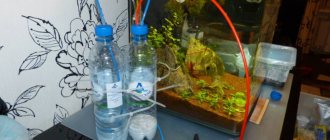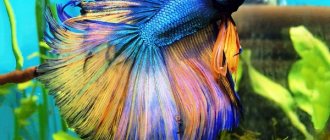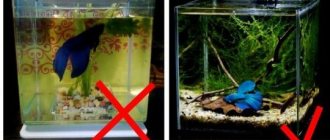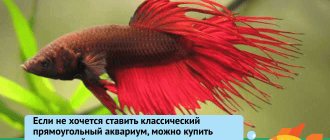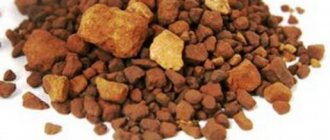Home › Aquarium care ›
( 2 ratings, average: 4.00 out of 5)
Are you already familiar with the expression “natural aquarium” or “natural aquarium” by Takashi Amano? If not, I recommend that you first familiarize yourself with the works of this famous Japanese aquascaper and be inspired by them. Because this article is about how to start a natural aquarium with live plants from scratch according to all the rules of Takashi Amano on the nutritious soil of Ada Amazonia. There will be a lot of BUKOFF, but even more photos, detailed step-by-step information on what to use, how to pour it, what decorations to use, live plants, equipment, what animals to add to your natural aquarium. If you are a beginner and just want to try yourself in both aquarium keeping and aqua design, follow these instructions and everything will work out!
Why dosage recommendations for different fertilizers vary greatly?
Why do the dosages of different fertilizers, from different manufacturers or homemade ones, differ, if calculated to increase the concentrations of nutrients in the aquarium?
The difference is in the systematic approach to growing aquarium plants. The systems are different, and the opinions are even more diverse. Some systems work well for very fast growth for the purpose of selling plants. Some systems work better for home aquariums. Let's sort these systems. There are commercial and non-commercial systems for growing aquarium plants. Among non-commercial systems we can highlight: Estimative Index (EI), Perpetual Preservation System (PPS), Walstad method. I won’t describe the essence of each, but you can use these keywords to search and figure them out yourself. These systems are not associated with the use of any specific branded fertilizer and can be used to determine the dosage of homemade aquarium fertilizers.
Commercial fertilizer dosing systems for aquarium plants are tied to specific fertilizer brands. Manufacturing companies can develop fertilizers for a specific category of customers. There are manufacturers who do not produce, for example, macrofertilizers for aquarium plants. That is, they are aimed at beginner aquarists. There are manufacturers who offer more universal fertilizer systems for both beginners and experienced aquarium plant lovers. But all commercial systems for fertilizing aquarium plants have one thing in common - they are designed for a wide range of aquarists, for home aquariums. While, for example, aquarium plant sellers may find the non-commercial Estimative Index system useful, which uses large doses of fertilizer, resulting in very rapid plant growth.
However, the growth rate is not always directly proportional to dosages. Some elements influence the aquarium plants' consumption of other elements, as depicted in Mulder's diagram. Some elements impair the accessibility of others, while some elements, on the contrary, stimulate them. This influences the fact that the growth rate of plants nonlinearly depends on the dosage of fertilizers. For example, if the concentration of phosphates in water in one aquarium is 0.5 mg/l, and in another aquarium it is twice as high - 1 mg/l, this does not mean that in the second aquarium the plants will grow twice as fast. It may even be that in an aquarium in which phosphates are not detected at all, or at the minimum of the test scale, the plants grow perfectly and at an acceptable rate.
Reduce the role of stress factors to increase yield
To begin with, let us turn to the data received from the KNIISH staff. The experiments were carried out under the guidance of candidates of agricultural sciences, leading researchers G.V. Chuvarleeva and G.M. Lesova, as well as junior researcher A.A. Mnatskanayan.
First, let’s determine the purpose of these studies. According to scientists, at the present stage of development of crop production, the number of unfavorable factors associated with the widespread use of toxic pesticides, pesticides and new generation antibiotics is increasing. Some of them negatively affect not only plants, but also the environment as a whole. In addition, an important task is to protect winter wheat from stresses of natural origin. Including from drought, waterlogging, frost and increased soil acidity. Therefore, scientists recommend introducing into traditional pesticide regimens drugs with maximum biological activity and minimal negative load on the ecosystem. Such as the products of the POLYDON® line. And the purpose of this study was to study the effectiveness of their use on winter wheat crops.
For this purpose, the preparations were tested on the winter wheat variety Yuka, sown after sunflower. It is characteristic that KNIISKh scientists conducted experiments on plants with both optimal and late sowing dates. But we will focus on the first option as the most indicative.
So, the repetition is threefold, the agricultural technology is adopted in the Krasnodar Territory. Ammophos (N16P52) and ammonium nitrate (N35) were applied to the soil here for basic tillage. In the spring, two feedings with ammonium nitrate (N50 and N20, respectively) were carried out with a difference of three weeks. In June, in the phase of milky-waxy ripeness, the crops were treated with a urea solution (N20).
Based on the research conducted, scientists noted the important role of pre-sowing treatment of seeds, as well as vegetative plants, with preparations from the POLYDON® line. Depending on the options, the increase in yield ranged from 3.2 to 14 c/ha. But first things first!
Rules for using fertilizers
- As we already know, after putting the aquarium into operation, there is no need to immediately add liquid nutrient mixtures to the water. Use only potassium at first;
- In order for fertilizers to be useful, you must strictly maintain a stable environment in the aquarium;
- When adding fertilizers for the first time, test the reaction of the flora;
- Never exceed the recommended dose of the nutrient, so as not to provoke strong plant growth;
- You can expect the effect after starting to use the fertilizer only after a month.
Fertilizers are an integral part of the full life of aquarium plants. If you use them according to the rules, you can achieve excellent results. Making fertilizers with your own hands or purchasing ready-made ones in the store is up to you to decide. The main thing is that both you and your plants enjoy it in the end.
Homemade or branded fertilizers, which is better?
Many novice aquarists are wondering: is it worth buying ready-made fertilizers or can you try making them yourself? Let's try to understand this issue in more detail. So, let’s look at what is the difference between homemade and branded fertilizers in a comparative table.
Table 1.
| Characteristic | Homemade | Branded |
| Price | It is more expensive due to the fact that it is necessary to purchase many components at once in large quantities, of which only a small proportion will be used. | The price is justified compared to the homemade option. |
| Recipe | Unchangeable | Constantly improving. |
| Shelf life | Short | Long |
| Effect of use | Good | Great |
| Consumer choice | This option is often chosen by chemists or biologists who are interested in the process of creating fertilizers. | The choice of the majority. |
From the editor: MEET ANOTHER PARROT
The conclusion is obvious - you should not waste time creating fertilizers with your own hands, of course, only if you are not an experienced chemist who gets great pleasure from it. It is much easier to buy ready-made bottles, the recipe of which is being modernized every day. Such fertilizers are additionally protected from fungi and mold, and can be selected to suit any needs of aquarium plants.
Recipe No. 1. "Parole Ermolaev MICRO" do it yourself
Macro- and microfertilizers developed by the popular aquascaper, chemist Sergei Ermolaev are known among aquarists under the name “UDO Ermolaev”. They are produced under the AQUAYER brand, but the developer makes no big secret of their composition.
To prepare an analogue of “UDO Ermolaev MICRO” with your own hands, you will need the following garden fertilizers:
| Fertilizer name | Weight, g |
| Potassium sulfate | 7,45 |
| Manganese sulfate (manganese sulfate) | 0,73 |
| Magnesium sulfate | 16,4 |
| Copper sulfate | 0,1 |
| inkstone | 1,44 |
| Zinc sulfate | 0,04 |
| Ammonium molybdate | 0,04 |
| Boric acid | 0,1 |
Next, all components are poured into a liter jar and 0.5 liters of distilled water are poured. The chelator Trilon B (aka Na-EDTA) is also added there in a volume of 2.5 g.
Everything is mixed well, the jar is immersed in hot water for a few minutes to warm up. The solution is shaken periodically. Once all the salts have dissolved, the fertilizer is ready for use. The recommended dosage is 1-5 ml per 70 liters of water every morning.
Tip #1. If you cannot get Trilon B, you can replace it with Antichlorosin, which is sold in garden stores. 2.63 g of it is added, and in this case iron sulfate is excluded from the composition.
- Aquarium microfertilizers are prepared only with distilled water. Salts contained in tap water unpredictably change the composition and effectiveness of fertilizing.
Choosing between homemade aquarium fertilizers and branded ones
Among aquarists there are supporters of using both homemade aquarium fertilizers and branded ones. Why do some people prepare fertilizers with their own hands, while others buy branded ones? Of course, the main advantage of homemade fertilizers is their price. The cost of such fertilizers may differ significantly from the price of branded fertilizers. My recipe for homemade aquarium fertilizers indicates the prices of chemical reagents, which will allow you to understand what the cost of such fertilizers is. However, you will have to buy chemicals in quantities that you may not be able to use over the entire time you have been interested in plant aquariums. Therefore, initially you will have to invest more in chemicals than in branded fertilizers. The path of using homemade fertilizers is usually taken by those aquarists who have a good basic knowledge of school chemistry and are generally interested in the chemistry of a planted aquarium and are keen on experimenting with their aquarium plants. Branded fertilizers are becoming the choice of aquarists who are more interested in the aesthetic side of plant aquarium keeping and experiments with preparing fertilizers seem to them like an extra headache and a waste of time. In addition, branded fertilizers are constantly being improved because manufacturers have financial motivation to do so. Public recipes for homemade fertilizers are usually unchanged and their improvement remains the responsibility of those who use them. Branded fertilizer formulas include various additives that improve their storage. While homemade fertilizers are easier to re-prepare than to improve their resistance to fungus and mold. For the same reason, homemade fertilizers are best stored in the refrigerator or frozen.
How to use liquid fertilizers correctly?
Many people are interested in the question: is it possible to simultaneously use fertilizers with macro and microelements? It is possible, but only by pouring them into the aquarium one by one. Dissolving in aquarium water, fertilizers are diluted to such a concentration that eliminates the possibility of sedimentation from the interaction of phosphates and cations from the two types of mixtures.
What is the best time of day to feed plants in an aquarium? Waking up with the first rays of the sun, every living thing on earth wants to eat, and the flora at the bottom of our water world is no exception. This means that early morning is the best time to feed plants.
Stage 5 - planting living plants in the middle ground
In a natural aquarium, a smooth transition is created from foreground plants to background plants. Long-stemmed plants are most often (and in our case) used to create a background. In the middle of our example, the plants may find themselves in the shade of a snag, so it is better to choose shade-loving plants. For the middle ground we will use cryptocorynes and epiphytes - plants that have almost no roots and therefore can be tied to driftwood (anubias, water ferns, bucephalandras).
Epiphytic plants are applied to the snag and tied in the right place using fishing line or nylon thread.
- Fern bolbitis gedeloti.
- Cryptocoryne albida, Cryptocoryne poetsch, Cryptocoryne wendta brown.
- Thai angustifolia fern.
Starting an aquarium and using fertilizers
The question of the advisability of applying fertilizers at the start-up stage of the aquarium is still being discussed. Although I always recommend fertilizing from the very first day of starting a planted aquarium, many people caution new aquarists against this approach. These precautions are only valid when using nutrient granular soils. In the case of using such soils, it is worth allowing the plant to look for nutrients in the soil, thereby developing the root system. Therefore, it makes sense to delay the application of aquarium fertilizers with nitrogen and phosphorus for several weeks, but Potassium must be applied in any case from the first day of launch.
Editorial: Haplochromis Boadzulu
If neutral soil is used in a planted aquarium, then without adding aquarium fertilizers the plants will have nowhere to get food from. Therefore, at the start-up stage in such an aquarium, it is necessary to apply at least minimal dosages of fertilizers.
Better drugs - better results
Another interesting experience was launched last year on the basis of KubSAU under the leadership of the director of the experimental station, candidate of agricultural sciences, associate professor A. A. Makarenko and the leading specialist of the experimental station, candidate of agricultural sciences E. E. Kochetova.
The start of the research, which included “Polydon” drugs, was given on October 1 of last year. The epicenter of attention was the winter wheat variety Adele, and the predecessor was corn for grain. The traditional three-fold repetition of the experiment allowed us to obtain the most accurate results.
So, the main mineral fertilizer was applied on October 2 (N20P80). Later, three feedings were carried out: on February 18 and March 11 - with ammonium nitrate (N40), on June 7 - with urea (N20).
As for experimental drugs, we are talking about the newest nutritional corrector POLYDON®IODE and growth stimulator ALFASTIM®. Let's start with the first product that helps solve several pressing problems at once. From the name it is clear that its primary function is to eliminate iodine deficiency. It has been proven that pre-sowing treatment with a preparation containing this microelement contributes to the formation of a more powerful root system and activation of tillering processes. And the use of POLYDON®IODE as a foliar feeding increases the gluten and protein content.
In addition, POLYDON®IODE improves the stress resistance of crops and also increases the coefficient of use of mineral fertilizers. And one more important advantage: it increases plant resistance to bacteria, fungi and viruses of various origins. We can say that this is an ideal product for “paired” work with fungicides.
The second drug used in the experiments was ALFASTIM®. It contains triterpene acids, auxin-cytokinin complex, fulvic substances and L-amino acids. This growth stimulator activates the most important metabolic reactions occurring in plant cells; increases the absorption of nutrients; promotes crop resistance to stress of various origins.
Features of adding liquid fertilizers to the aquarium.
In this chapter of the article I will try to provide answers to frequently asked questions regarding the use of liquid fertilizers. These are specific issues that are rarely written about in instructions and given full explanations. For example, the question often arises about the joint application of fertilizers with macro- and microelements. Can they be added to the aquarium at the same time? This question arises because many people know that phosphate from a mixture of macroelements can form insoluble compounds with cations of a mixture of microelements. However, this is possible provided that liquid macro- and microfertilizers are directly mixed. Once liquid fertilizer has been added to the aquarium, its components are very diluted. The formation of insoluble compounds under such dilution conditions is impossible. Therefore, Macro and Micro can be introduced into the aquarium at the same time.
On the forums you can read that macroelements are consumed more by the plant at night and therefore, supposedly, it is better to apply liquid macrofertilizers at night. This is a dubious statement and is not generally accepted in the field of plant physiology. To absorb nutrients, the plant expends energy, which it receives from light. It is better to add all liquid fertilizers to the aquarium at the beginning of daylight hours, or just before it begins, following the logic that the plant requires nutrition when the lights are turned on.
In the past, aquarium fertilizer manufacturers recommended fertilizing once a week. Apparently, such recommendations indulged the laziness of aquarists, fearing to frighten off potential buyers of their products by the condition of daily use of fertilizers. But the fact remains that the more evenly the liquid fertilizer is applied to the aquarium, the more effective it is. Fertilizing your aquarium daily, for example, along with feeding the fish, will always give better results than fertilizing once a week. But in the case of aquariums without CO2 supply, lighting less than 0.5 watt/l and slow-growing plants, the difference from daily and weekly fertilization is not significant.
What should you do if the aquarium is left unattended during your vacation? Of course, this will not have a positive effect on the aquarium, but some measures can be taken. Following the logic described in the previous paragraph, you can slow down the growth of aquarium plants and, therefore, reduce the plants’ demands for stable nutrition. To do this, you can reduce the carbon dioxide supply in advance to the level necessary to maintain the pH between 7 and 7.5, reduce the lighting level by half and reduce the dosage of fertilizers. Before leaving, add a dose of fertilizer for the week ahead. Lowering the temperature by a few degrees can also be effective.
What are scientists talking about?
When it comes to theory, it is logical at a certain point to move on to data obtained in practice. The drugs produced by POLYDON Agro are successfully used in different parts of our country. And we have more than once published competent opinions received directly from agronomists and managers of agricultural enterprises. All of them spoke only positively about the microfertilizers and growth stimulants that this company produces.
And now it’s time to give the floor to Russian scientists: they have something to tell about the use of “Polydon” drugs. Numerous experiments were carried out in the Krasnodar Territory, where the products of this brand are in high demand.
The latest results came from two leading scientific institutions: the Krasnodar Research Institute (KNIISH) and the Kuban State Agrarian University (KubSAU). Based on the results of the work done, their employees published reports that show the feasibility of using the POLYDON® line of drugs on winter wheat, as well as a number of other crops.
Recipe No. 1 (NPK fertilizer for aquarium plants)
| Nitrogen fertilizer | Phosphorus fertilizer | Potassium-containing | ||
| N * (g/l) | K (g/l) | P *(g/l) | K (g/l) | K (g/l) |
| 11,5 | 32 | 1,6 | 2,01 | 38 |
| * - I personally find it more convenient to calculate fertilizers in the form of N and P, but aquarists find it more convenient when nitrogen is presented in the form of nitrates, and phosphorus in the form of phosphates. Therefore, for convenience, I have indicated the values of nitrates and phosphates in parentheses. |
I recommend that when making fertilizers for aquarium plants according to this recipe, do not do everything in “one bottle”, but do it in different bottles in order to be able to make adjustments in dosage if necessary. The fact is that plants do not consume nutrients evenly and imbalances in nutrition may occur, which can lead to algae outbreaks. Also, the concentration of nitrogen and phosphorus in water is affected by aquarium animals, which release these elements during their life activities.
Editorial: Platidoras
Nitrogen fertilizer
To prepare a fertilizer containing nitrogen (in the form of nitrates), you need to dissolve 82.88 grams of potassium nitrate in 700 ml of water. After complete dissolution, add water to the resulting solution to the 1000 ml mark.
1 ml of this fertilizer increases the concentration of potassium by 0.64 mg/l and nitrogen by 0.23 mg/l (or 1.02 mg/l nitrates) in 50 liters of water: Approximate application schedule and dosage of fertilizer
Phosphorus fertilizer
To prepare a fertilizer containing phosphorus (in the form of phosphates), you need to dissolve 7.01 grams of potassium monophosphate in 700 ml of water. After complete dissolution, add water to the resulting solution to the 1000 ml mark.
1 ml of this fertilizer increases the concentration of potassium by 0.04 mg/l and phosphorus by 0.03 mg/l (or 0.1 mg/l phosphates) in 50 liters of water: Approximate application schedule and dosage of fertilizer.
Potassium fertilizer
To prepare a fertilizer containing potassium, you need to dissolve 84.76 grams of potassium sulfate in 700 ml of water. After complete dissolution, add water to the resulting solution to the 1000 ml mark.
1 ml of the resulting fertilizer increases the concentration of potassium in 50 liters of water by 0.76 mg/l: Approximate application schedule and dosage of fertilizer.
The numbers are in favor of “polydons”
But let's get back to the tests. Employees of the Kuban State Agrarian University conducted experiments with nine different options. In the first, control, wheat seeds were treated only with a two-component fungicidal dressing. “Polidonovskaya” products were not used in this case.
The next three options involved the pre-sowing use of POLYDONE®IODE and ALFASTIM® in various dosages and combinations. In five more variants, not only pre-sowing, but also foliar treatment was carried out. In this case, the drugs were used during the spring growing season, at different phases of crop development.
And now – briefly about the results obtained.
– The use of nutrition corrector POLYDON®IODE (50 ml/t) during pre-sowing seed treatment contributed to the emergence of the fastest and most vigorous seedlings.
– Counts and measurements of crops carried out before going into winter showed: the depth of the tillering node, the height of plants and the volume of the root system differed slightly in different variants of the experiment. But there is an option that has “taken the lead” in terms of the volume of the root system. The following scheme was used on it: two-component fungicidal disinfectant (2 l/t), POLYDONE®IODE (50 ml/t) and ALFASTIM® (50 ml/t).
– After the resumption of the spring growing season, this option again became a leader. The largest number of shoots and leaves was recorded in this area. The maximum was the height of the plants, as well as the volume of the root system.
– Scientists noted the following dynamics: when using the drug POLYDON®IODE in the spring, in the tillering phase, in dosages of 50 and 100 ml/ha, the number of productive stems was 564 and 584 pcs/m2, respectively. This turned out to be significantly higher than with other options.
– In the area where the maximum dosage of microfertilizer (POLYDONE®IODIUM 100 ml/ha) was practiced, the highest grain weight was recorded (1.47 g). For comparison: in the control, this indicator turned out to be minimal – 1.32 g.
Based on the results of the tests, scientists came to the conclusion: in the conditions of the central zone of the Krasnodar Territory, the use of the drug POLYDON®IODE during the period “end of tillering - beginning of booting” allows increasing the number of productive stems. And leaf-by-leaf processing in the heading phase contributes to a significant increase in grain weight per ear. These factors have a direct impact on crop productivity, which means that the use of “Polydonov” products is possible – and necessary! – recommend to agricultural enterprises.
By the way, KubSAU employees did not stop at winter wheat alone. They tested “polydons” on sunflower, corn, and sugar beets. And everywhere microfertilizers and growth stimulants from this line showed excellent results. They influenced the yield and quality of the resulting products: they contributed to an increase in the oil content of sunflower, the dry matter content of the “queen of the fields” and the sugar yield of sugar beets. We will tell you more about these tests in the next issues of our newspaper. Now let’s move on to another topic that is relevant for crop production. And it is associated with nitrogen losses when applying mineral fertilizers.
How often should liquid fertilizer be applied?
Despite the assurances of manufacturers that once a week is enough, daily feeding still has a much better effect on plants. For this purpose, it is necessary to evenly distribute the weekly dose of fertilizer into 7 doses or follow the instructions.
If you are planning a long trip and want to keep your plants safe and sound, then try reducing the nutritional requirements of your greens. To this end, do the following:
- It is necessary to reduce the amount of CO2 so that the pH is within the acceptable range of 7-7.5;
- Reduce lighting by half;
- Lower the water temperature by 1-2 degrees;
- On the day of departure, feed the plants with a weekly dose of fertilizer.
What macro- and microelements are required for growth?
Macronutrients that plants need include:
- chlorine;
- sodium;
- silicon;
- magnesium;
- potassium and calcium;
- phosphorus, sulfur and other important components.
Potassium performs an important function in the synthesis of carbohydrates. Phosphorus is needed in order for the process of respiration and nutrition of plants to take place.
Microelements include:
- copper;
- zinc;
- iron;
- cobalt and molybdenum;
- boron;
- manganese.
Reference! Iron helps plants absorb oxygen and gain a healthy appearance.
Aquarium fertilizer calculator
Fans of aquarium plants often have questions: “How much does fertilizer Y increase the concentration of element X.” Such questions arise especially often for those who use aquarium tests immediately after adding fertilizer. Although daily application implies a very small increase in concentrations, even of macronutrients. Use the calculator below to see for yourself. On the left, the concentrations of elements in the original fertilizer are filled in if the composition is known. On the right, the concentrations of these elements are calculated as a result of adding a dose of fertilizer to a specific volume of aquarium water.
| Aquarium volume, l: |
| Fertilizer dose, ml: |
| Element | Concentration in fertilizer, g/l | Concentration in the aquarium, mg/l |
| K | — | |
| N | — | |
| P | — | |
| Ca | — | |
| Mg | — | |
| Fe | — | |
| Mn | — | |
| B | — | |
| Cu | — | |
| Zn | — | |
| Mo | — | |
| Co | — |
When is fertilizer really necessary?
There are situations when fertilizers are simply vital and without them plants can simply die. Let's take a closer look at when you should feed aquarium vegetation with ready-made fertilizers:
- When carbon dioxide is supplied to the aquarium;
- Lots of plants and few fish;
- Plants grow slowly or die.
If the number of plants is significantly greater than the number of fish that can feed them with their natural excrement, then they will certainly begin to experience a deficiency of nutrients. At the same time, stronger plants will begin to suck energy from small and weak bushes, which will certainly soon get sick and die. To prevent the suffering and death of greenery, it is best to steadily feed it from the outside.


